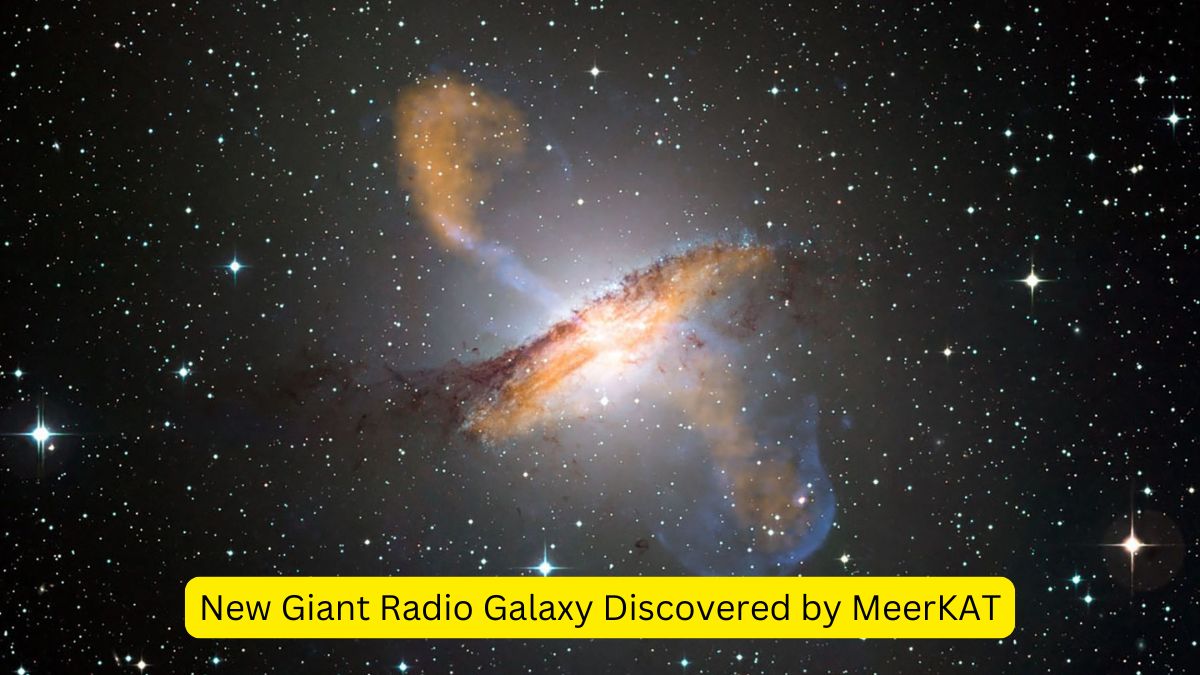An international team of astronomers led by Kathleen Charlton from the University of Cape Town, South Africa, has used the MeerKAT radio telescope to discover a new giant radio galaxy (GRG) in the Cosmological Evolution Survey (COSMOS) field. This discovery was detailed in a research paper published on November 11, 2024. Giant radio galaxies are rare, colossal structures known for their immense size and powerful emissions.
The newly identified galaxy, MGTC J100022.85+031520.4, has remarkable properties that contribute to the study of galaxy evolution and radio source formation.
Key Findings of the Study
Research Instrument
- The MeerKAT radio telescope in South Africa was employed to study giant radio galaxies at high frequencies (about 1.0 GHz).
- This research is part of the MeerKAT International GHz Tiered Extragalactic Exploration (MIGHTEE) survey.
What are Giant Radio Galaxies (GRGs)?
- GRGs are defined by their projected linear size exceeding 2.3 million light years.
- They are rare, grow primarily in low-density environments, and display jets and lobes of synchrotron-emitting plasma.
- These galaxies are significant for studying radio source evolution and formation.
Discovery of MGTC J100022.85+031520.4:
- MGTC J100022.85+031520.4 is the first identified GRG in this study.
- It is hosted by an elliptical galaxy, SDSS J100022.85+031520, with a redshift of about 0.1034.
- The galaxy has a projected linear size of 4.2 million light years, making it exceptionally large.
- It has a mass of 93 trillion solar masses and a total power of 597 ZW/Hz at 1,284 MHz.
Key Characteristics of MGTC J100022.85+031520.4:
- The galaxy has an estimated dynamical age of about one billion years.
- The jet power is measured at one million QW.
- The galaxy is located at the center of the galaxy cluster WHL J100022.9+031521, which places it in a rare group of only 4% of GRGs found in cluster environments.
- The galaxy’s bent morphology and location at the cluster’s center suggest it shares properties with galaxies hosting wide-angle-tail (WAT) radio sources.
- WAT radio sources are known for their characteristic C-shaped morphology, typically formed when ram pressure from the intracluster medium bends the lobes of the galaxy’s jets.
Significance of the Discovery
- The discovery of MGTC J100022.85+031520.4 adds new insights into the role of cluster environments in the formation and evolution of GRGs.
- The study highlights the importance of using high-frequency observations to better understand the dynamics and properties of these colossal galaxies.
| Summary/Static | Details |
| Why in the news? | Discovery of a New Giant Radio Galaxy with MeerKAT |
| Research Team | Led by Kathleen Charlton, University of Cape Town, South Africa. |
| Telescope Used | MeerKAT radio telescope (South Africa) |
| Survey Name | MeerKAT International GHz Tiered Extragalactic Exploration (MIGHTEE) |
| Discovery | New GRG discovered: MGTC J100022.85+031520.4 |
| GRG Size | Projected linear size of 4.2 million light years |
| Host Galaxy | Elliptical galaxy SDSS J100022.85+031520 |
| Mass | 93 trillion solar masses |
| Dynamical Age | 1 billion years |
| Location | Central galaxy in the WHL J100022.9+031521 galaxy cluster |
| Significance of the Discovery | Insights into the formation and evolution of GRGs, particularly in cluster environments |



 LVM3-M6 Rocket Set to Launch on December...
LVM3-M6 Rocket Set to Launch on December...
 Michaela Benthaus to Make History as Fir...
Michaela Benthaus to Make History as Fir...
 Indian Team Bags Global Top Honour at NA...
Indian Team Bags Global Top Honour at NA...







